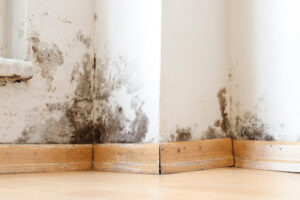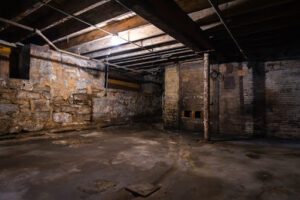Foundation cracks in the basement can be alarming. More often than not, they indicate serious structural issues that could affect your home’s stability, as well as your safety. Addressing them promptly and effectively is essential to maintaining your property’s integrity. In this guide, we’ll teach you how to fix foundation cracks in the basement, identify the types of crevasses, and understand the repair methods and preventive measures.
Understanding Foundation Cracks
Foundation Crack Types
Foundation cracks come in various forms that determine the appropriate repair method.
- Hairline cracks are thin, shallow cracks that typically appear due to minor shrinkage as concrete cures.
- Vertical cracks, common in poured concrete foundations, result from soil settlement or concrete shrinkage and are usually less severe but need attention to prevent water infiltration.
- Horizontal cracks, which are more serious, often indicate significant structural stress caused by soil pressure against the foundation walls.
- Diagonal cracks can occur due to differential settlement of the foundation and typically appear at a 30-45 degree angle, varying in severity.
- Lastly, stair-step cracks, common in brick or block foundations, follow the mortar joints in a step-like pattern and indicate foundation movement.
Causes Of Foundation Cracks
Several factors can contribute to the formation of foundation cracks—soil movement, for example. Expansive soils that swell when wet and shrink when dry exert pressure on foundation walls. Over time, the tension drives concrete to break.
Poor drainage around the foundation can cause water accumulation, which saturates the soil, resulting in hydrostatic pressure that cracks the foundation.
Large trees near the foundation can cause soil displacement and foundation movement as their roots grow and expand.
Poor construction practices, such as inadequate concrete curing or improper soil compaction, can also lead to foundation weaknesses and cracks.
Lastly, natural disasters such as earthquakes and floods can cause significant stress on the foundation, leading to cracks and damage.
When To Worry About Foundation Cracks
Not all foundation cracks are a reason for immediate concern. However, certain signs indicate that a situation might be more serious.
- Cracks wider than 1/8 inch or those that continue to grow over time need professional evaluation.
- Horizontal and diagonal cracks often indicate structural issues and should be assessed promptly.
- Any crack that allows water to seep into the basement or crawl space should be repaired to prevent further damage and mold growth.
- If foundation walls are bulging or bowing inward, it indicates significant pressure and requires immediate attention.
DIY Inspection Tips
Foundation repairs must be performed by professionals. However, before making a call, you can conduct a preliminary inspection of your foundation cracks. Measure the width and length of the micro-cracks with a ruler and note any changes over time. Look for signs of water seepage or dampness around it.
You can also use a level to check if the walls are bulging or tilting. Sticking doors or windows, gaps in walls, or uneven floors are common indications of foundation movement.
Professional Techniques For Repairing Foundation Cracks
For more severe or extensive cracks, professional intervention is non-negotiable. The techniques employed by experts are more advanced, and designed to ensure long-term stability and safety of your home. Here’s an in-depth look at some of the most effective professional repair methods:
Carbon Fiber Straps
Carbon fiber straps are bonded to the foundation wall with high-strength epoxy, providing additional support and preventing further movement. This method is particularly effective for larger horizontal cracks, which often indicate significant structural stress.
The carbon fiber straps are lightweight yet incredibly strong. As a non-intrusive solution, they reinforce the wall without requiring extensive excavation or major disruption to your home. Professional installation ensures these straps are correctly applied, maximizing their strength and effectiveness.
Steel Braces
Steel braces are installed against the foundation wall to reinforce it and prevent further bowing or movement. They are often used in conjunction with other repair techniques, such as carbon fiber straps or wall anchors, to provide a comprehensive solution.
The installation of steel braces requires precise engineering and expertise to ensure they are placed correctly and provide the necessary support. Professional contractors will assess the specific needs of your foundation and implement the best combination of techniques to address the problem effectively.
Underpinning
Underpinning involves extending the foundation to a more stable soil layer or adding support to distribute the weight more evenly. This technique is used for significant foundation settlement issues and is crucial for stabilizing homes that have experienced considerable movement.
The process can involve different methods, depending on the soil conditions and the extent of the settlement. Professional underpinning ensures the foundation is securely anchored to a stable substrate, preventing further movement and potential damage.
Preventing Future Foundation Cracks
Proper Drainage Solutions
Proper drainage around your home is key in preventing foundation cracks. Also, the ground around your home should slope away from it to avoid water accumulation.
Keep the gutters clean and ensure downspouts direct water away from the foundation. Consider installing French drains to divert water away from the foundation. In areas with high water tables, a sump pump can help keep the basement dry.
Landscaping Considerations
Your landscaping choices can impact your foundation’s stability.
Plant trees and shrubs away from the foundation to prevent root interference. Use mulch to help retain soil moisture and reduce the need for watering near the foundation. Also, keep in mind that ground cover plants can minimize soil erosion and maintain stable moisture levels around the foundation.
Regular Maintenance
Regular maintenance will help you identify and address potential issues before they become serious.
Conduct periodic inspections of your foundation and basement or crawl space for signs of cracks or movement. Address any new cracks as soon as they appear to prevent them from worsening. Use dehumidifiers in the basement to maintain optimal humidity levels and prevent moisture buildup.
How To Choose The Right Professional
Selecting a qualified, reputable foundation repair professional will give you peace of mind with effective and lasting repairs. Look for contractors who have a proven track record and positive customer reviews. Verify that they are licensed and insured to protect against any potential liabilities.
A responsible professional will conduct a thorough inspection and provide a detailed assessment of the foundation issues along with recommended repairs. They should also offer warranties or guarantees on their work, assuring you of the quality and durability of the solution applied.
Stop Cracks In Their Tracks: Secure Your Home Now
If you’re dealing with significant foundation cracks or unsure about the severity of the issue, don’t hesitate to seek professional help.
Fixing foundation cracks in the basement means maintaining your home’s structural integrity and value. By understanding the types of cracks, their causes, and the appropriate repair methods, you can address them early on, effectively. Regular inspection and preventive measures will also help prevent future issues and protect your foundation.
At AMC 911, our experienced team is always ready to provide expert foundation repair services tailored to your needs. Request a quote today and ensure your home remains safe and stable for years to come!


















